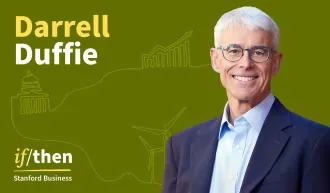Jeff Smisek: Adapting to Ever-Changing Challenges
The United Airlines CEO says amid shifting regulations, economic storms, and other issues, it's key to inspire employees to believe in the future.
April 01, 2011
United and Continental Airlines merged last year to form the world’s largest carrier, an aviation colossus with $30 billion in revenue that ferries 144 million passengers to 371 cities in 59 countries annually, oversees a fleet of 1,200 aircraft, and employs 87,000 highly unionized workers.
Now flying under the United name, the business faces high fuel costs - its planes burn an estimated $25,000 per minute in jet fuel - rigid government regulation, and natural disasters such as the volcano that grounded air traffic in Europe for days last spring.
But those are just some of the factors that keep the airline business ever changing and “unbelievably fascinating,” said Jeff Smisek, president and chief executive officer of Chicago-based United Continental Holdings. “There is no business like the airline business,” he said.
Smisek - an astute manager who Fortune magazine recently called “King of the Skies” - discussed his company and leadership strategy during a “View From The Top” address at Stanford GSB on April 26.
The aviation industry is tough for several reasons, including “brutal” government regulation, he told the MBA student audience.
While the nation’s airlines were officially deregulated by the government in 1978, Smisek quipped that United and others are now “the most heavily regulated deregulated business there is.”
Some rules governing the industry, such as safety mandates, make perfect sense, Smisek admits. But others are expensive and oppressive, including $27,500 per passenger fines if airplanes are stuck on a taxiway and unable to take off for more than 3 hours. In many cases, Smisek said, those delays aren’t United’s fault but rather the result of the air traffic control system, which uses “antiquated” radar technology.
Rising fuel costs - the company’s largest expense that’s estimated at $25,000 per minute - also impact the carrier’s profitability. So did last year’s eruption of a volcano in Iceland that spewed copious amounts of ash that grounded thousands of flights throughout Europe and, in 2003, the SARS (severe acute respiratory syndrome) virus outbreak that dramatically cooled air travel to certain regions of the world.
“We’re subject to external events that most businesses aren’t,” Smisek said. “Who could have thought that, when you were planning for the year, you’d be subject to a volcano or SARS or any number of these external events?”
Then he joked, “It’s a tough business; it’s a stressful business. I sleep like a baby; I wake up every two hours and cry. “
However, the industry’s rapid change and diversity is also a powerful recruiting draw. The airline world encompasses everything from international law to accounting, finance, labor relations, lobby groups, consumers, and “really cool [aviation technology] toys,” he told the audience.
Smisek, the former top executive at Continental Airlines, is striving to blend the two airlines’ distinctly different cultures.
The businesses employ workers doing the same jobs who are represented by the same union, workers that are represented by different unions, and workers who are not unionized. “You have to bring them together, and that’s a long process,” he explained. “If you are going to bring 87,000 people together, as we are in this merger, you’ve got to have a vision for them. People want to believe in the future, but you’ve got to show them what the future is going to be. So, having a clear and simple plan is incredibly valuable for leading change and for bringing businesses together.”
Getting out of the executive suite to meet face to face with employees from all ranks across the company is one of Smisek’s top culture-building initiatives. He’s met thousands of workers over the years with a down-home style based on talking to people in break rooms and on airline flight decks. He said he also spends an hour each day answering emails he receives from staffers: “It’s really important. I want a culture where anybody can ask me a question and get an open and honest answer.”
As they become the next generation of managers, Smisek urged Stanford students to also strive to get to know workers from every level of their organizations. “Always remember that there are so many people who work really hard all through the night to make you look good, and you need to make sure you are thanking those people and building those relationships,” he said.
The “View From The Top” speaker series brings leaders of business and social sector communities to the business school to share their views on leadership. It is organized through the school’s Center for Leadership Development and Research.
An Air Force officer’s son, Smisek graduated with an economics degree from Princeton University before heading Harvard Law School. He practiced corporate finance and securities law at Vinson & Elkins in Texas, and left that practice to join Continental as senior vice president and general counsel in 1995. He went on to become president in 2004 and then president and chief operating officer in 2008.
Last year, he helped negotiate the merger with United and took over as CEO of the combined company after the deal closed in October.
He closed his talk by urging the Stanford MBAs to “ignore the herd” mentality and not pursue investment banking or consulting just “because it’s cool.” Instead, Smisek advised, “If you have a passion for investment banking, consulting, or working in the high-tech sector, go for it. What matters is enjoying your work, being proud of what you do, and believing in the company.”
For media inquiries, visit the Newsroom.
Explore More

Jensen Huang on How to Use First-Principles Thinking to Drive Decisions

Why Investors Throw Money at Eccentric CEOs



